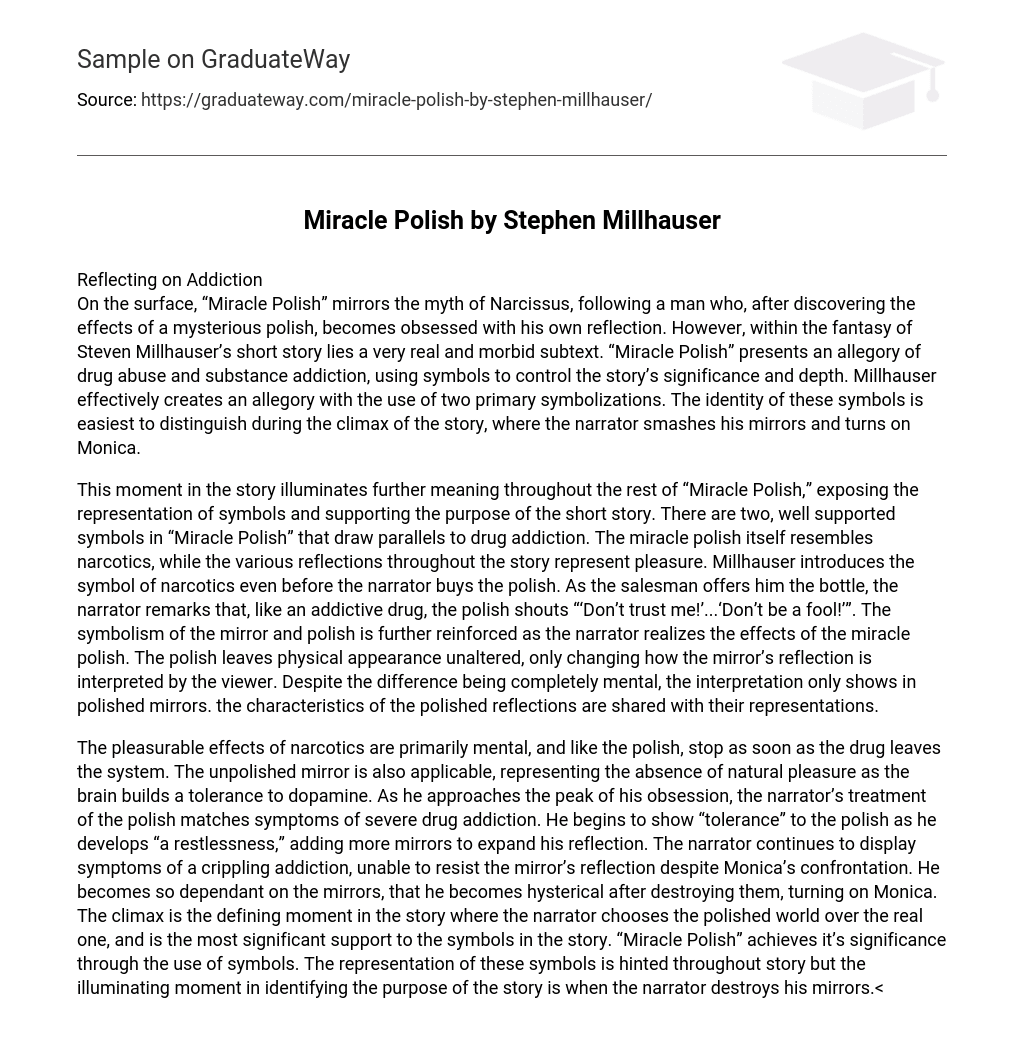Reflecting on Addiction
On the surface, “Miracle Polish” mirrors the myth of Narcissus, following a man who, after discovering the effects of a mysterious polish, becomes obsessed with his own reflection. However, within the fantasy of Steven Millhauser’s short story lies a very real and morbid subtext. “Miracle Polish” presents an allegory of drug abuse and substance addiction, using symbols to control the story’s significance and depth. Millhauser effectively creates an allegory with the use of two primary symbolizations. The identity of these symbols is easiest to distinguish during the climax of the story, where the narrator smashes his mirrors and turns on Monica.
This moment in the story illuminates further meaning throughout the rest of “Miracle Polish,” exposing the representation of symbols and supporting the purpose of the short story. There are two, well supported symbols in “Miracle Polish” that draw parallels to drug addiction. The miracle polish itself resembles narcotics, while the various reflections throughout the story represent pleasure. Millhauser introduces the symbol of narcotics even before the narrator buys the polish. As the salesman offers him the bottle, the narrator remarks that, like an addictive drug, the polish shouts “‘Don’t trust me!’…‘Don’t be a fool!’”. The symbolism of the mirror and polish is further reinforced as the narrator realizes the effects of the miracle polish. The polish leaves physical appearance unaltered, only changing how the mirror’s reflection is interpreted by the viewer. Despite the difference being completely mental, the interpretation only shows in polished mirrors. the characteristics of the polished reflections are shared with their representations.
The pleasurable effects of narcotics are primarily mental, and like the polish, stop as soon as the drug leaves the system. The unpolished mirror is also applicable, representing the absence of natural pleasure as the brain builds a tolerance to dopamine. As he approaches the peak of his obsession, the narrator’s treatment of the polish matches symptoms of severe drug addiction. He begins to show “tolerance” to the polish as he develops “a restlessness,” adding more mirrors to expand his reflection. The narrator continues to display symptoms of a crippling addiction, unable to resist the mirror’s reflection despite Monica’s confrontation. He becomes so dependant on the mirrors, that he becomes hysterical after destroying them, turning on Monica. The climax is the defining moment in the story where the narrator chooses the polished world over the real one, and is the most significant support to the symbols in the story. “Miracle Polish” achieves it’s significance through the use of symbols. The representation of these symbols is hinted throughout story but the illuminating moment in identifying the purpose of the story is when the narrator destroys his mirrors.
The purpose of “Miracle Polish” is to illustrate the descent of a drug user as he is consumed by addiction, focusing on the mental impact of narcotics on an individual. The destruction of the mirrors, followed by the narrator’s sudden rage toward Monica is essential to understanding the influence and power of the miracle polish. The narrators sudden outburst at Monica is the most significant display of his dependency. It becomes clear that upon realizing the extent of his actions, the narrator regrets choosing Monica over the reflection. The moment of illumination also has significance in the remainder of the short story. The narrator laments the miracle polish in the final paragraph, but does not even acknowledge Monica’s existence. The actions of the narrator after destroying the mirrors is essential to understanding the purpose of the “Miracle Polish”
Although “Miracle Polish” explores the morbid topic of drug addiction, Millhauser uses a cleaning fluid and a self reflecting object to represent the addictive substance that consumes the narrator’s life. Millhauser frequently utilizes these small literary connections in his writing to add effect to the short story, giving the sense that even a deep analysis of “Miracle Polish” only scratches the surfaces the surface of its complete meaning





